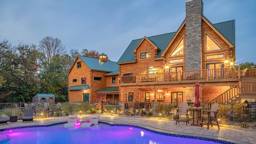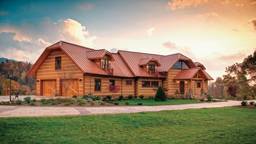
Here are six tips to help you begin manage log home construction costs effectively with careful planning and attention to detail.
1. Plan first.
In the high excitement of planning a dream home, details sometimes get passed over. Costs for things like appliances, lighting and cabinetry might wind up getting postponed until after construction starts, making for unpleasant surprises. Make sure you’ve included costs for everything in your home before breaking ground, especially if you are acting as your own contractor.
2. Avoid change orders.
Change orders are how contractors deal with work not included in their original contract. This added expense may result from a planning oversight or unexpected conditions encountered on the job site. Because changes during construction often require removing or altering recently completed work, in addition to the change itself, change-order work often costs more than if the work had been part of the original plan.
3. Stick to a simple footprint, standard dimensions and right angles.
Basic building designs cost less. Excavation proceeds faster. Foundations and roofs can be completed more quickly, sometimes with substantially less material. Many building materials come in 2- or 4-foot increments.
Building dimensions closer to these units result in less waste and less labor. Think square corners. Angles other than right angles waste more material and require much more labor during construction. Reducing the number of corners, especially in solid-log buildings, can lead to substantial cost savings.
4. Choose low-maintenance exteriors.
When cutting costs, consider more than just direct construction costs. Think of the ongoing maintenance that is a part of home ownership. By protecting log surfaces from sun and weather, porches or wide eaves can cut the frequency of exterior log treatment in half, saving thousands of dollars of maintenance cost. Metal roofs cost more than conventional shingles, but a shingle roof will need replacing several times during the lifespan of one metal roof.
5. Invest in efficient mechanical systems.
Include high-efficiency mechanical equipment for heating and cooling your log home, and be sure your mechanical contractor sizes equipment properly. Insist on Manual J calculations, if your building codes don’t already require them. Beware of any contractor who works from “rule of thumb.” Heating and cooling systems are still undergoing dramatic changes, which affect both construction and operating cost.
6. Postpone expensive finishes.
If your budget is very tight, look at costs that you can defer. Inexpensive finish items can help keep construction costs down, while leaving the opportunity for upgrades later when your budget allows. For example, inexpensive sheet-vinyl flooring can be attractive and later serve as underlayment for a ceramic tile or slate floor.
Inexpensive cabinetry can serve well until you are ready to splurge on custom cabinetry. Depending on design, you may be able to add decks and porches later. However, be cautious of changes that affect the structure of your home. Changing bearing walls, posts or beams is usually costly, as is work that requires a lot of demolition.
Preparing for Construction
To get the most out of postponing elements of construction, anticipate them before construction starts. For example, consider the added thickness of tile or slate flooring even if you plan to start with inexpensive vinyl sheet flooring. If you plan to add a porch, include it in your blueprints, labeled “future porch.” This way, building-code officials will be able to point out any structural concerns that could result in costly changes later.
Also, you or your builder will be able to include bracing or structural framing in anticipation of the addition. Construction-cost savings begin with careful planning and attention to detail. If you don’t have a lot of construction expertise, discuss your plans with someone who does. Even if you pay for professional assistance, you may shave tens of thousands of dollars off project costs.
Hit the Road
Most new log homes are built on undeveloped land. You’ll need access for vehicles, materials and workers. That means a road. A clearing through the woods might seem like the solution, but an access road must handle traffic in all kinds of weather. A graded roadbed topped with gravel should do the job. It’ll have to handle log deliveries, usually by tractor-trailer. If the site is especially difficult to reach, you can use a forklift to offload the logs and carry them to the site.
You might consider establishing a staging area for logs and other materials at this unloading point and then using the forklift to deliver them as needed. Local excavators and road builders can you on the best solution for temporary access. When construction is complete, you may use the temporary road as the base for your driveway or return it to a natural state and build a permanent driveway elsewhere.
Jim Cooper, a former log-home builder and general contractor, is author of Log Homes Made Easy and The Log Home Project Planner. He is a LEED Accredited Professional and Certified Passive House Consultant.











